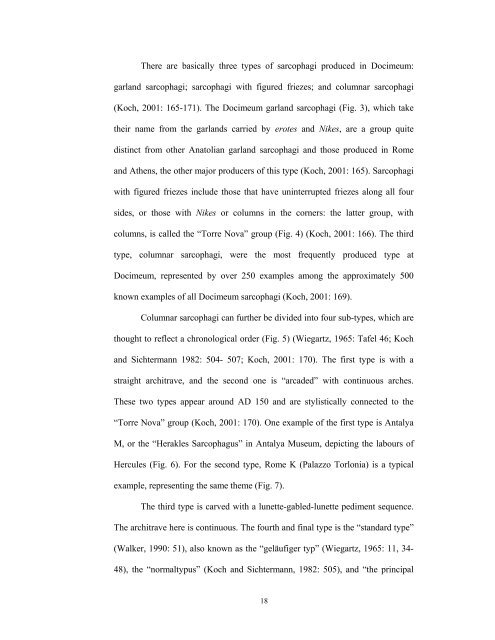To My Family and Uğraş Uzun - Bilkent University
To My Family and Uğraş Uzun - Bilkent University
To My Family and Uğraş Uzun - Bilkent University
You also want an ePaper? Increase the reach of your titles
YUMPU automatically turns print PDFs into web optimized ePapers that Google loves.
There are basically three types of sarcophagi produced in Docimeum:<br />
garl<strong>and</strong> sarcophagi; sarcophagi with figured friezes; <strong>and</strong> columnar sarcophagi<br />
(Koch, 2001: 165-171). The Docimeum garl<strong>and</strong> sarcophagi (Fig. 3), which take<br />
their name from the garl<strong>and</strong>s carried by erotes <strong>and</strong> Nikes, are a group quite<br />
distinct from other Anatolian garl<strong>and</strong> sarcophagi <strong>and</strong> those produced in Rome<br />
<strong>and</strong> Athens, the other major producers of this type (Koch, 2001: 165). Sarcophagi<br />
with figured friezes include those that have uninterrupted friezes along all four<br />
sides, or those with Nikes or columns in the corners: the latter group, with<br />
columns, is called the “<strong>To</strong>rre Nova” group (Fig. 4) (Koch, 2001: 166). The third<br />
type, columnar sarcophagi, were the most frequently produced type at<br />
Docimeum, represented by over 250 examples among the approximately 500<br />
known examples of all Docimeum sarcophagi (Koch, 2001: 169).<br />
Columnar sarcophagi can further be divided into four sub-types, which are<br />
thought to reflect a chronological order (Fig. 5) (Wiegartz, 1965: Tafel 46; Koch<br />
<strong>and</strong> Sichtermann 1982: 504- 507; Koch, 2001: 170). The first type is with a<br />
straight architrave, <strong>and</strong> the second one is “arcaded” with continuous arches.<br />
These two types appear around AD 150 <strong>and</strong> are stylistically connected to the<br />
“<strong>To</strong>rre Nova” group (Koch, 2001: 170). One example of the first type is Antalya<br />
M, or the “Herakles Sarcophagus” in Antalya Museum, depicting the labours of<br />
Hercules (Fig. 6). For the second type, Rome K (Palazzo <strong>To</strong>rlonia) is a typical<br />
example, representing the same theme (Fig. 7).<br />
The third type is carved with a lunette-gabled-lunette pediment sequence.<br />
The architrave here is continuous. The fourth <strong>and</strong> final type is the “st<strong>and</strong>ard type”<br />
(Walker, 1990: 51), also known as the “geläufiger typ” (Wiegartz, 1965: 11, 34-<br />
48), the “normaltypus” (Koch <strong>and</strong> Sichtermann, 1982: 505), <strong>and</strong> “the principal<br />
18
















